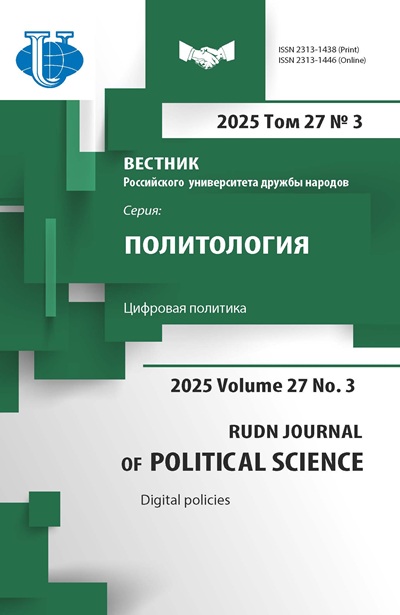Political Categories in Discussions Within Local Online Communities: Empirical Research Methodology Employing Volgograd Case Analysis
- Authors: Babkin A.A.1
-
Affiliations:
- HSE University
- Issue: Vol 27, No 3 (2025): Digital policies
- Pages: 507-519
- Section: POLITICS ONLINE
- URL: https://journal-vniispk.ru/2313-1438/article/view/348833
- DOI: https://doi.org/10.22363/2313-1438-2025-27-3-507-519
- EDN: https://elibrary.ru/NXGDEN
- ID: 348833
Cite item
Full Text
Abstract
In the context of digitalization of society, neighborhood communication is increasingly moving online. The communication of neighbors on public social media platforms creates extensive archives of data that can be used for political science research. These data open up new opportunities for the study of grassroots politics, group identities, political activism, etc. Nevertheless, there is currently a gap in research related to the lack of comprehensive methods that allow analyzing neighborhood online communities on a city scale, not limited to individual cases. The purpose of this work is to eliminate the existing gap by proposing a methods for identifying neighborhood online communities on a city scale using data from the VKontakte social network. Based on this methodology, an attempt is being made to identify in the discussions of the neighboring communities of the city of Volgograd an array of publications in which political categories occur. The paper describes the process of searching for neighborhood online communities, and also describes the preprocessing of text data. A mechanism is proposed for cleaning the corpus of texts from advertisements, which represented a wide proportion of publications, but acted as noise that hindered the main task. Publications mentioning political categories are identified by automatically encoding the cleared corpus into groups of keywords, followed by rechecking. The resulting archive, covering 17 years of neighborhood interaction, made it possible to determine, through the use of thematic modeling tools, the main periods of development of neighborhood communities. Starting from short non-political messages in groups of neighboring youth, ending with an established political repertoire: the work of homeowners associations; interaction with representatives of authorities, mainly executive ones, to solve local problems; organization and participation in local patriotic events. The most active types of neighborhood online-communities were identified: territorial public self-governments, communities of shareholders and microdistrict communities.
About the authors
Alexander A. Babkin
HSE University
Author for correspondence.
Email: s4p4@yandex.ru
ORCID iD: 0009-0004-1491-9517
postgraduate student at the Department of Politics and Management of the Faculty of Social Sciences
Moscow, Russian FederationReferences
- Abramov, R.N. (2017). Kommunal’nye konflikty i sosedskie soobshhestva v novyh prigorodah: opyt kejs-stadi. Social’nye i prostranstvennye izmerenija sovremennogo megapolisa, 280–297. (In Russian).
- Chernysheva, L., & Gizatullina, Je. (2021). VKontakte and the Neighbors: Features and Practices of Hybrid Neighboring in a Large Housing Estate in Saint Petersburg, Russia. Laboratorium: Russian Review of Social Research, 13(2), 39–71. (In Russian). https://doi.org/10.25285/2078-1938-2021-13-2-39-71 EDN: LCUBQU
- Chernysheva, L.A., & Zaporozhets, O.N. (2023). Digital Platforms and Urban Mobilizations: How Locality Redefines Connective Action. Monitoring of Public Opinion: Economic and Social Changes, 4, 124–148. (In Russian). https://doi.org/10.14515/monitoring.2023.4.2352 EDN: EIVNRC
- Detochenko, L.V. (2018). “Linejnyj” gorod: istoriko-geograficheskie osobennosti territorial’noj organizacii, hozjajstvennoj i transportnoj sostavljajushhih (na primere Volgograda). Vestnik Udmurtskogo universiteta. Serija “Biologija. Nauki o Zemle”, 28(2), 200–210. (In Russian).
- Egger, R., & Yu, J. (2022). A topic modeling comparison between LDA, NMF, Top2Vec, and bertopic to demystify twitter posts. Frontiers in sociology, 7, 886498. https://doi.org/10.3389/fsoc.2022.886498 EDN: AICULW
- Erete, S.L. (2015). Engaging around neighborhood issues: How online communication affects offline behavior. Proceedings of the 18th ACM Conference on Computer Supported Cooperative Work & Social, Computing, 1590–1601. https://doi.org/10.1145/2675133.2675182
- Golodova, A.D., Miheeva, I.A., & Rechkunova, E.R. (2023). Gettoizacija otdel’nyh rajonov Volograda na primere Beketovki i Nizhnego Traktornogo. Mezhdunarodnyj zhurnal gumanitarnyh i estestvennyh nauk, (4–1), 62–66. (In Russian). EDN: SDLMZX
- Hampton, K.N. (2003). Grieving for a lost network: collective action in a wired suburb special issue: ICTs and community networking. The Information Society, 19(5), 417–428. https://doi.org/10.1080/714044688
- Karanov, D.P. (2022). Faktory konsolidacii lokal’nyh soobshhestv spal’nyh mikrorajonov (na primere prigoroda Sankt-Peterburga). Simvol nauki, (5–1), 88–91. (In Russian).
- López, C., Farzan, R., & Lin, Y.R. (2017). Engaging neighbors: The double-edged sword of mobilization messaging in hyper-local online forums. Proceedings of the 28th ACM Conference on Hypertext and Social Media, 255–264.
- Mohotti, W.A. (2020). Unsupervised text mining: effective similarity calculation with ranking and matrix factorization (Doctoral dissertation). Queensland University of Technology. https://doi.org/10.5204/thesis.eprints.199456
- Mordvinova, P.A. (2023). Gorodskie i rajonnye pabliki “Vkontakte” kak novye media. Vestnik VGU. Serija: Filologija. Zhurnalistika, 20, 1–10. (In Russian).
- Nenko, A., & Nedoseka, E. (2022). Tsennosti gorodskoy sredy v diskurse sosedskikh onlayn-soobshchestv. Zhurnal sotsiologii i sotsialnoy antropologii, 25(1), 217–251. https://doi.org/10.31119/jssa.2022.25.1.8 (In russian). EDN: XFXHSL
- Rogers, E.M., Collins‐Jarvis, L., & Schmitz, J. (1994). The PEN Project in Santa Monica: Interactive communication, equality, and political action. Journal of the American Society for Information Science, 45(6), 401–410. https://doi.org/10.1002/(sici)1097-4571(199407)45:6<401::aid-asi6>3.0.co;2-n
- Sumskaja, A.S. (2012). Social’nye seti kak instrument vovlechenija v nevirtual’nuju (real’nuju) aktivnost’ (na primere otkrytoj gruppy social’noj seti “Vkontakte” “Za sohranenie berezovoj roshhi v 18 mkr Cheljabinska”). Znak: problemnoe pole mediaobrazovanija, (1), 19–25. (In Russian).
Supplementary files








